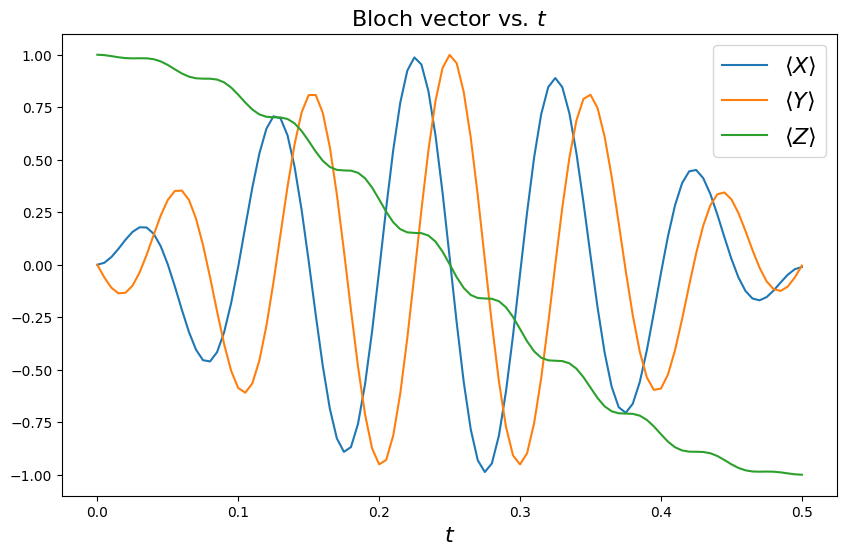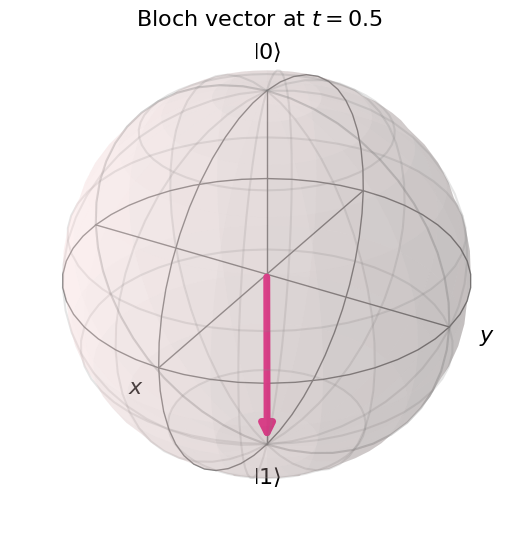Simulating Rabi oscillations with noise and decoherence¶
In this tutorial we walk through an example of solving using qiskit_dynamics the time evolution
of a qubit being driven close to resonance. The model that we solve consists of a single qubit
perturbed by a sinusoidal drive. In addition, will consider energy relaxation and decoherence terms
modeled by using a Lindblad master equation.
In the sections below we define a model, solve the dynamics and plot the qubit oscillations using the following steps:
Setup a
Solverwith the Hamiltonian modelDefine the initial state and simulation times, and evolve the system state.
Plot the qubit state as a function of time and discuss the results.
Solve again the the model with jump operators for the Lindblad dissipator, and plot the results.
In the first step below, we model the time evolution of a qubit’s state taken as a two-level system, using the Schrödinger equation with a Hamiltonian containing a diagonal term of frequency \(\nu_z\) and a transverse term of amplitude \(\nu_x\) and harmonic driving frequency \(\nu_d\) (see how the Hamiltonians are derived on Qiskit Textbook page on Introduction to Transmon Physics),
where \(\{X,Y,Z\}\) are the Pauli matrices (also written as \(\sigma^a\) with \(a\in\{x,y,z\}\)).
1. Setup the solver with the Hamiltonian model¶
In the following, we will set \(\hbar=1\) and fix some arbitrary time units, with all frequency
parameters scaled accordingly. Below, we first set a few values for these frequency parameters, and
then setup the Solver class instance that stores and manipulates the model to be solved,
using matrices and Signal instances. For the time-independent \(z\) term we set the
signal to a constant, while for the trasverse driving term we setup a harmonic signal.
import numpy as np
from qiskit.quantum_info import Operator
from qiskit_dynamics import Solver, Signal
nu_z = 10.
nu_x = 1.
nu_d = 9.98 # Almost on resonance with the Hamiltonian's energy levels difference, nu_z
X = Operator.from_label('X')
Y = Operator.from_label('Y')
Z = Operator.from_label('Z')
s_p = 0.5 * (X + 1j * Y)
solver = Solver(
static_hamiltonian=.5 * 2 * np.pi * nu_z * Z,
hamiltonian_operators=[2 * np.pi * nu_x * X],
)
2. Solve the system¶
We now define the initial state for the simulation, the time span to simulate for, and the intermediate times for which the solution is requested, and solve the evolution.
from qiskit.quantum_info.states import Statevector
from qiskit.quantum_info import DensityMatrix
t_final = .5 / nu_x
tau = .005
y0 = Statevector([1., 0.])
n_steps = int(np.ceil(t_final / tau)) + 1
t_eval = np.linspace(0., t_final, n_steps)
signals = [Signal(envelope=1., carrier_freq=nu_d)]
sol = solver.solve(t_span=[0., t_final], y0=y0, signals=signals, t_eval=t_eval)
3. Plot the qubit state¶
Below we define a local function that calculates the qubit’s Pauli expectation values as a function of time (which define also the Bloch vector),
The same function plots both these three curves, and the Bloch vector at the final time, depicted in 3D on the Bloch sphere. We will reuse this function in the next section.
We see that for the parameters we have defined, the qubit has completed almost exactly a \(\pi\)-rotation of the qubit Bloch vector about the \(x\) axis, from the ground to the excited state (with many intermediate rotations of its transverse component, whose amplitude increases and decreases). This mechanism of Rabi oscillations is the basis for the single-qubit gates used to manipulate quantum devices - in particular this is a realization of the \(X\) gate.
from qiskit.visualization import plot_bloch_vector
import matplotlib.pyplot as plt
%matplotlib inline
fontsize = 16
def plot_qubit_dynamics(sol, t_eval, X, Y, Z):
n_times = len(sol.y)
x_data = np.zeros((n_times,))
y_data = np.zeros((n_times,))
z_data = np.zeros((n_times,))
for t_i, sol_t in enumerate(sol.y):
x_data[t_i] = sol_t.expectation_value(X).real
y_data[t_i] = sol_t.expectation_value(Y).real
z_data[t_i] = sol_t.expectation_value(Z).real
_, ax = plt.subplots(figsize = (10, 6))
plt.rcParams.update({'font.size': fontsize})
plt.plot(t_eval, x_data, label = '$\\langle X \\rangle$')
plt.plot(t_eval, y_data, label = '$\\langle Y \\rangle$')
plt.plot(t_eval, z_data, label = '$\\langle Z \\rangle$')
plt.legend(fontsize = fontsize)
ax.set_xlabel('$t$', fontsize = fontsize)
ax.set_title('Bloch vector vs. $t$', fontsize = fontsize)
plt.show()
display(plot_bloch_vector([x_data[-1], y_data[-1], z_data[-1]],
f'Bloch vector at $t = {t_eval[-1]}$'))
plot_qubit_dynamics(sol, t_eval, X, Y, Z)


4. Redefine the model with damping and decoherence¶
Now we add to our simulation an environment modeled as a memory-less (Markovian) bath, solving the Lindblad master equation with the same Hamiltonian as before, but accounting also for energy relaxation and decoherence terms. We simulate the dynamics to times longer than the typical relaxation times \(T_1=1/\Gamma_1\) and \(T_{\phi}=1/\Gamma_2\). The qubit’s state has to be described using a density matrix, now evolving according to the Lindblad master equation,
We take the Lindblad dissipator to consist of two terms,
The action of energy relaxation terms describing damping into the environment with rate \(\Gamma_1\) are generated by
with \(\sigma^{\pm}= \frac{1}{2}\left(X\pm i Y\right)\).
The second dissipator describes (“pure”) dephasing with rate \(\Gamma_2\), and reads
We use the function defined above for calculating the Bloch vector components, which can be done
since in qiskit and in qiskit-dynamics the syntax of many functions is identical for both
state vectors and density matrices. The shrinking of the qubit’s state within the Bloch sphere due
to the incoherent evolution can be clearly seen in the plots below.
Gamma_1 = .8
Gamma_2 = .2
t_final = 5.5 / max(Gamma_1, Gamma_2)
y0 = DensityMatrix.from_label('0')
solver = Solver(
static_hamiltonian=.5 * 2 * np.pi * nu_z * Z,
hamiltonian_operators=[.5 * 2 * np.pi * nu_x * X],
static_dissipators=[np.sqrt(Gamma_1) * s_p, np.sqrt(Gamma_2) * Z]
)
n_steps = int(np.ceil(t_final / tau)) + 1
t_eval = np.linspace(0., t_final, n_steps)
signals = [Signal(envelope=1., carrier_freq=nu_d)]
sol = solver.solve(t_span=[0., t_final], y0=y0, signals=signals, t_eval=t_eval)
plot_qubit_dynamics(sol, t_eval, X, Y, Z)

